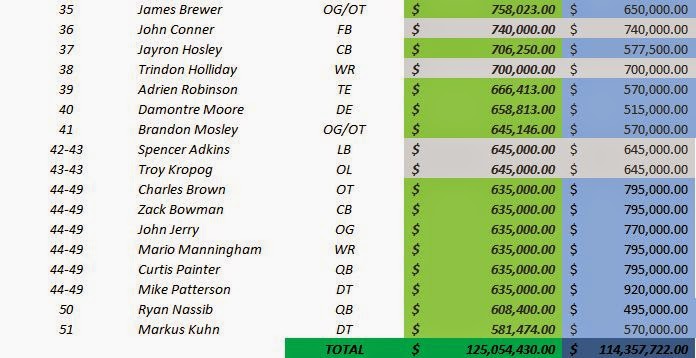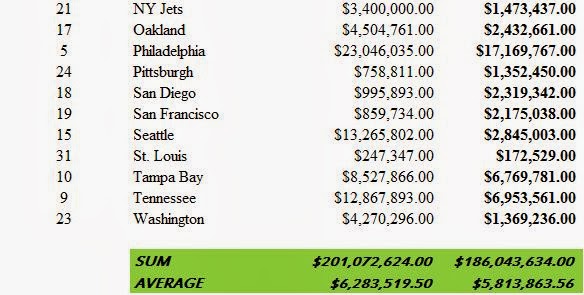The 2014 league year officially begins at 4 pm EST on March 11, 2014. That's roughly 11 and a half days from now, as of the timing of this post. The Top 51 Salary Cap accounting rule will kick in at that time as well. Right now, the Giants have 51 players under contract. Their cap numbers are as follows at the moment:

As can be seen, the Giants have $110,933,676 in cap dollars allocated to the 51 players who count towards the active player cap numbers thus far. In addition to this, they have $2,778,141 in Dead Money set aside for 11 players, 9 of whom are no longer on the team (Eric Herman and Charles James being the only exclusions).
The total for the cap numbers and Dead Money in 2014 is $113,711,817. This is then subtracted from what's called the team's adjusted cap. What exactly is this? I explained it in this post from last June (June 8th, 2013 to be exact):
The five factors that change a team's unadjusted cap into an adjusted cap, as explained in the article I linked above, are as follows:
- Carryover money from the previous year
- Finalized Grievances
- Cap penalties
- LTBE (Likely to be earned) bonuses
- NLTBE (Not likely to be earned) bonuses
What is an unadjusted cap you may ask? That is the bottom line figure that is not adjusted. This figure was set at $126.3 million at the end of the regular season. It has since went up to $128 million, and then $130 million. Most recently, it has been rumored to go up even more to between $132 & $133 million. as per the following tweets by Tom Pelissero and Luke Jones.
If the figure is set at $133 million, then that would be a mark-up of $6.7 million cap dollars from what it started out as being earlier this off-season. This would mean that in order to determine how much cap money the Giants have free at this point, you would subtract the total amount of allocated cap dollars ($113,711,817) from the actual---or projected---unadjusted cap ($133,000,000). If this were done with the figures in parentheses, then the Giants would have $19,288,183 in free cap space to use, as of this moment.
The voided contracts of Corey Webster ($1,000,000 in cap savings) & Brandon Myers ($3,250,000 in cap savings) have already been factored into this equation for those who are wondering. There are still other moves that are likely to be made as well. The contract of Chris Snee, highlighted in red above, is going to change. If the Giants cut him, they stand to gain $6.8 million in cap savings. Even if he remains on the team for the 2014 season, his $11.3 million cap number will most certainly go down significantly via a pay cut, as in the case of David Diehl last off-season. In my opinion, it would be a mistake to keep Snee at this juncture in his career following the past two injury-filled seasons, but that's neither here nor there.
There's also the the case of Eli Manning and Antrel Rolle, both highlighted in yellow above. Both of them are interesting cases. Eli has two years left on his deal, while Rolle has only one. Word now is that the Giants won't extend Eli this off-season. Whether or not this is actually true is open to speculation. If they wait, it'll get done next off-season for sure unless Eli gets injured in 2014. The Giants won't let their franchise QB become a FA, even if he turns 35 after the 2015 season. I wouldn't say for sure though right now that the Giants won't extend Eli this off-season though. Antrel Rolle's case is also one to watch. He'll turn 32 next December, in what will be his tenth year. He had previously refused to have the terms of his contract changed, but he has spoke up about this issue this off-season stating that he'd be open to an extension, which is a win-win for both the Giants and himself: they'd lower his cap number, and keep him for a few more years at a lower cap rate, and in turn, Rolle would actually make more in cash. There are two other players though who are not as cut and dried when it comes to dealing with their contract issues: namely David Baas and Mathias Kiwanuka.
I wrote about the possibility of making David Baas a post-June 1st cut in the article that I wrote for BigBlueInteractive.com below back in October:
Mathias Kiwanuka is another guy who is a possibility for the post-June 1st cut designation. At the same time, he's also a guy who is a possibility for a pay cut. Baas and Kiwi have the 4th highest ($8.225 M) & 7th highest ($7.050 M) cap numbers on the Giants' roster at this time respectively. Those figures will undoubtedly go down since their performance, health, and age are no longer commensurate with their on-field production, or lack thereof, more accurately stated. If the Giants designate Baas as a post-June 1st cut, they'll stand to gain $5 million in cap savings as of June 2nd, as opposed to only $1.775 million in cap savings if he is a standard cut. If they do the same with Kiwi, they stand to gain $4.425 in cap savings if he is a post-June 1st cut, as opposed to only $1.8 million in cap savings if he is a standard cut. In the case of Baas, I'd opt to make him a post-June 1st cut, but the case of Kiwanuka is a little different. Kiwi's case depends on Tuck in my estimation. It's no secret how much the Giants value Defensive Ends in their 4-3 defense. If Tuck walks in free agency---a realistic possibility--then Kiwi has an increased chance of remaining with the Giants.
The Giants' 5 Restricted Free Agents are also going to factor into the cap equation (Henry Hynoski, Mark Herzlich, Jim Cordle, Spencer Paysinger, & Da'Rel Scott). We'll soon know what course of action they take with these players. March 11th is also the date that tenders for RFAs are made. If the salary cap is $130,000,000 then the figures will be as follows, from overthecap.com:
- 1st round tender = $3,043,000
- 2nd round tender = $2,138,000
- Right of First Refusal/Original round tender = $1,398,000
After doing some math, the tenders would go up the following figures of the cap is raised to $133,000,000:
- 1st round tender = $3,113,223
- 2nd round tender = $2,187,338
- Right of First Refusal/Original round tender = $1,430,262
If I had to guess, I'd say that Da'Rel Scott won't even be tendered, but that the rest of the RFAs, who are all Undrafted Free Agents, could receive the right of first refusal tender, with Paysinger having a shot at receiving the 2nd round tender. If PAysinger were to receive the 2nd round tender and the rest of the RFA (sans Scott) were to receive ROFR tenders, then that would take out about $6.5 million from the Giants' remaining estimated cap space amount of $19,288,183 mentioned above. More moves will continue to be made, most certainly in the cases of Snee and Rolle, and probably at least one of Baas and Kiwankuka.




























